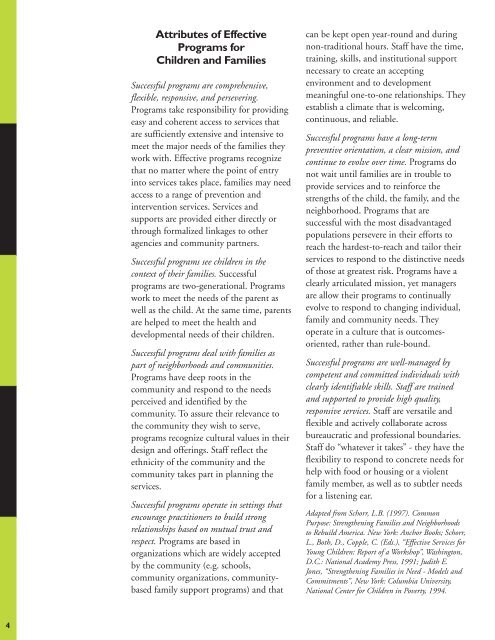School-Linked Services: Child Opportunity Zone Family Centers
School-Linked Services: Child Opportunity Zone Family Centers
School-Linked Services: Child Opportunity Zone Family Centers
You also want an ePaper? Increase the reach of your titles
YUMPU automatically turns print PDFs into web optimized ePapers that Google loves.
4<br />
Attributes of Effective<br />
Programs for<br />
<strong>Child</strong>ren and Families<br />
Successful programs are comprehensive,<br />
flexible, responsive, and persevering.<br />
Programs take responsibility for providing<br />
easy and coherent access to services that<br />
are sufficiently extensive and intensive to<br />
meet the major needs of the families they<br />
work with. Effective programs recognize<br />
that no matter where the point of entry<br />
into services takes place, families may need<br />
access to a range of prevention and<br />
intervention services. <strong>Services</strong> and<br />
supports are provided either directly or<br />
through formalized linkages to other<br />
agencies and community partners.<br />
Successful programs see children in the<br />
context of their families. Successful<br />
programs are two-generational. Programs<br />
work to meet the needs of the parent as<br />
well as the child. At the same time, parents<br />
are helped to meet the health and<br />
developmental needs of their children.<br />
Successful programs deal with families as<br />
part of neighborhoods and communities.<br />
Programs have deep roots in the<br />
community and respond to the needs<br />
perceived and identified by the<br />
community. To assure their relevance to<br />
the community they wish to serve,<br />
programs recognize cultural values in their<br />
design and offerings. Staff reflect the<br />
ethnicity of the community and the<br />
community takes part in planning the<br />
services.<br />
Successful programs operate in settings that<br />
encourage practitioners to build strong<br />
relationships based on mutual trust and<br />
respect. Programs are based in<br />
organizations which are widely accepted<br />
by the community (e.g. schools,<br />
community organizations, communitybased<br />
family support programs) and that<br />
can be kept open year-round and during<br />
non-traditional hours. Staff have the time,<br />
training, skills, and institutional support<br />
necessary to create an accepting<br />
environment and to development<br />
meaningful one-to-one relationships. They<br />
establish a climate that is welcoming,<br />
continuous, and reliable.<br />
Successful programs have a long-term<br />
preventive orientation, a clear mission, and<br />
continue to evolve over time. Programs do<br />
not wait until families are in trouble to<br />
provide services and to reinforce the<br />
strengths of the child, the family, and the<br />
neighborhood. Programs that are<br />
successful with the most disadvantaged<br />
populations persevere in their efforts to<br />
reach the hardest-to-reach and tailor their<br />
services to respond to the distinctive needs<br />
of those at greatest risk. Programs have a<br />
clearly articulated mission, yet managers<br />
are allow their programs to continually<br />
evolve to respond to changing individual,<br />
family and community needs. They<br />
operate in a culture that is outcomesoriented,<br />
rather than rule-bound.<br />
Successful programs are well-managed by<br />
competent and committed individuals with<br />
clearly identifiable skills. Staff are trained<br />
and supported to provide high quality,<br />
responsive services. Staff are versatile and<br />
flexible and actively collaborate across<br />
bureaucratic and professional boundaries.<br />
Staff do “whatever it takes” - they have the<br />
flexibility to respond to concrete needs for<br />
help with food or housing or a violent<br />
family member, as well as to subtler needs<br />
for a listening ear.<br />
Adapted from Schorr, L.B. (1997). Common<br />
Purpose: Strengthening Families and Neighborhoods<br />
to Rebuild America. New York: Anchor Books; Schorr,<br />
L., Both, D., Copple, C. (Eds.), “Effective <strong>Services</strong> for<br />
Young <strong>Child</strong>ren: Report of a Workshop”, Washington,<br />
D.C.: National Academy Press, 1991; Judith E.<br />
Jones, “Strengthening Families in Need - Models and<br />
Commitments”, New York: Columbia University,<br />
National Center for <strong>Child</strong>ren in Poverty, 1994.



